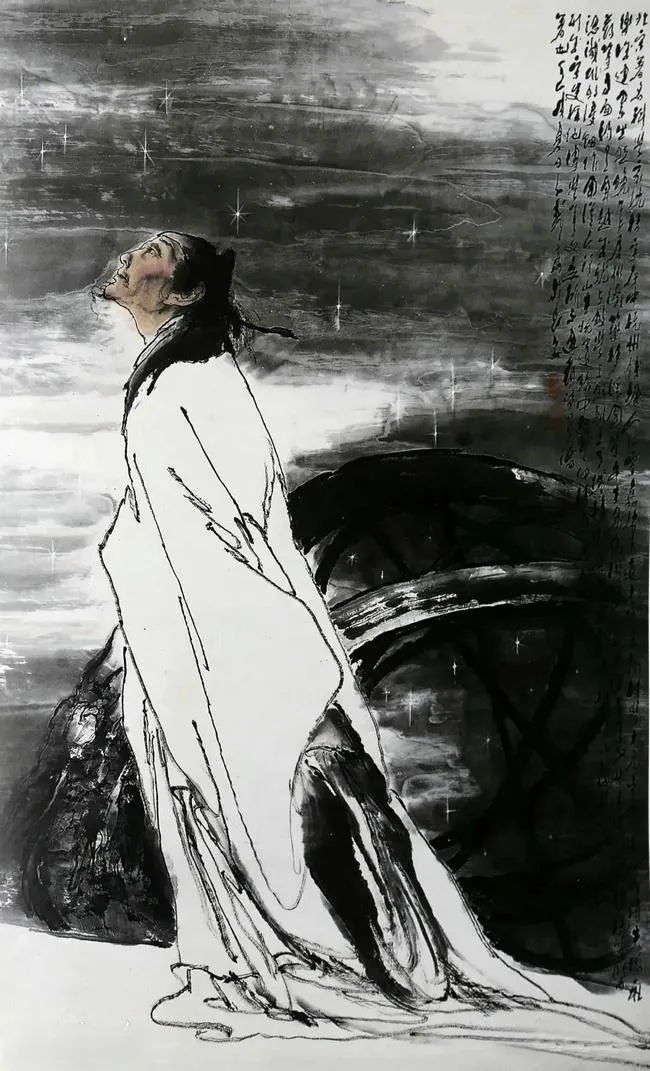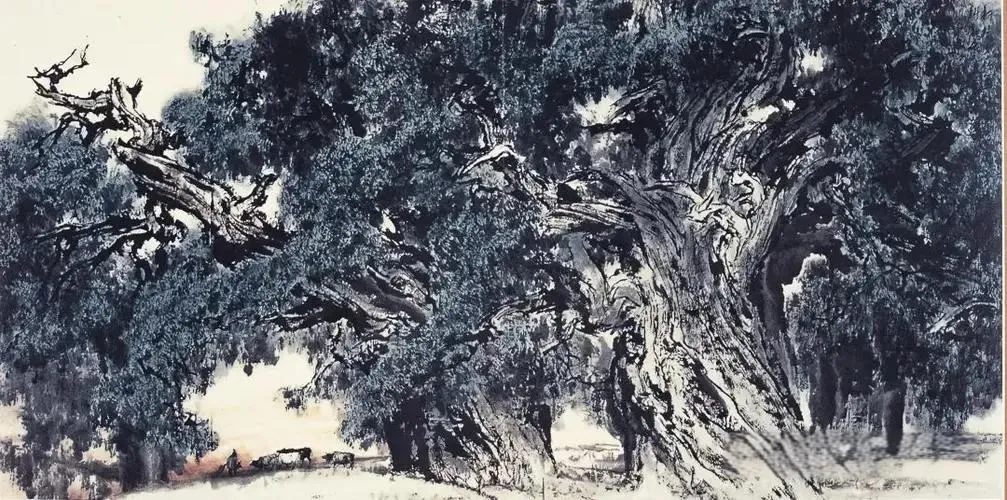王子武,生于丙子年冬月,陕西西安人,现当代人物画家,长安画派代表。其人,书画界传奇,美术界高峰。终生执着于中国绘画与书法,立志“画不出奇画至死”。
新中国成立,蒋兆和、方增先诸大家之艺术影响深远,写实水墨人物画蓬勃发展。至六七十年代,王子武崛起,成杰出代表,艺成卓然。今多元艺术语境,研习其艺,具历史与现实双重意义。
Wang Ziw, born in the winter month of the Year of the Rat, hails from Xi'an, Shaanxi. He is a contemporary figure painter and a representative of the Chang'an painting school.He is a legend in the calligraphy and painting world, a pinnacle in the art world. Devoted his life to Chinese painting and calligraphy, vowing to "paint extraordinary paintings until death." He is the renowned Chinese painter Wang Ziw.
With the founding of New China, the artistic achievements of masters like Jiang Zhaohe and Fang Zengxian had a profound impact, leading to the flourishing of realistic ink figure painting. By the sixties and seventies, Wang Ziw emerged as a prominent representative, achieving remarkable artistic success. In today’s diverse artistic context, studying his art holds both historical and contemporary significance.

纵观王子武从艺数十载,写生人物画占据重分。王子武于癸卯年卒业西安美院国画系,西北浓烈风情与厚重历史滋养其丰神俊朗之形与沉稳内敛之性。其画敏感而超拔,作品细腻浓烈,情感纯净,引人注目。画中儿童、学生、工人、农民、文士、墨客形象,皆生动传神,若面目可见。此生动塑造,需艺术家与描绘对象有真切情感交流,同理心态,情感交流,碰撞中显,流泻于画。
正如王子武言:“画好人物,先于对象有强烈感情与表现欲望,笔墨间才有情意内容。”内容者,情意综合,画家塑造之形象,传达性格、气质与情绪。王子武接触对象,心态细观察,体验其心理,以精准笔墨、灵动线条,刻画生动质朴、自然纯粹之形象。每一写生对象,皆为经典,平凡大众形象跃然纸上,感人至深。
诚然,王子武之卓然天赋与高洁品格,与其天生艺才,澄净心态不可分。数十年如一日,坚定持守中国艺术家之责任与担当。孤居陋室,苦心孤诣,潜心艺事,隔绝纷扰,苦守艺志与赤诚。正如其自画像题诗:“惨淡经营愧无能,枉费衣食哭无声。画不出奇画到死,不负此生了此生。”
此艺术初心,使其艺于默耕中无声焕发璀璨光芒,一经面众,惊艳世人。此坚定持守,艺术家、读书人之自觉定力,无需他人督促,亦不倚社会认定,乃发自心灵深处之热爱与狂热之“偏执”。正此热爱与偏执,使吾辈见证王子武对传统文化之执着与坚守。
Throughout his decades-long career, Wang Ziw's figure sketches held a significant place. Graduating from Xi'an Academy of Fine Arts in the Year of the Rabbit, the intense regional customs and rich history of the Northwest nurtured his handsome and composed demeanor. His sensitivity and exceptional artistic perception rendered his works delicate, intense, and emotionally pure, captivating viewers. His depictions of children, students, workers, farmers, scholars, and literati are vivid and lifelike, as if the subjects were present. Such lifelike portrayal requires genuine emotional connection and empathy between the artist and the subject, manifesting through continuous interaction and reflection on canvas.
As Wang Ziw said, "To paint figures well, one must first have a strong affection and desire to express for the subject; only then will the brushwork contain emotion and meaning." The content, a blend of emotion and intention, allows the artist to convey the character, spirit, and mood of the figures. Wang Ziw carefully observed and experienced the psychology of his subjects, using precise brushwork and dynamic lines to create lifelike, simple, and pure images. Each sketch subject became aic, making ordinary figures vividly come alive on paper, profoundly moving viewers.
Indeed, Wang Ziw's extraordinary talent and noble character are inseparable from his innate artistic gift and serene mindset. For decades, he steadfastly upheld the responsibilities and duties of a Chinese artist. Living humbly, he devoted himself to his craft, isolating himself from distractions, and maintaining his artistic passion and sincerity. As he inscribed in his self-portrait, "Struggling in vain, ashamed of my inability, wasting sustenance with silent cries. Painting extraordinary works until death, this life shall not be in vain."
This artistic dedication allowed his works to silently radiate brilliance through diligent effort, astonishing the world once unveiled. Such steadfast adherence is the inherent determination of an artist and scholar, needing no external prompting or societal validation, arising from a deep love and fervent "obsession." This very passion and obsession allow us to witness Wang Ziw's unwavering commitment to traditional culture.

在中国美术界百花齐放之际,王子武仍沿心中明确之道前行,自然坚守传统文化精髓。其作品纯粹、自然,仍探求不止。
于王子武而言,坚定态度、持守平静、寂寞道路、简单生活,皆为平淡日常,亦是其生活与艺术之乐。其女王小燕云:“父潜心绘画,毕生奉献美术。好观察,少言辞,常游艺境...”由此观之,王子武常于多彩社会中静默观察,深刻体会,不宣于口,将内心感悟融于画,满腔赤诚洒笔墨,于笔语墨彩中通达性灵,感悟生命。
检索王子武写生之作,多成于六七十年代。时值中国水墨人物画之特期,社会变幻,艺情高涨。林风眠、徐悲鸿等引欧式素描,后引苏式素描,皆主导国画课程。素描教学改革,水墨画迎新机遇。
Amidst the flourishing diversity of the Chinese art world, Wang Ziw continued on his clear path, naturally preserving the essence of traditional culture. His works remained pure, natural, and clear, with unceasing exploration.
For Wang Ziw, a steadfast attitude, maintaining tranquility, enduring solitude, and leading a simple life were all part of his daily routine and his joy in life and art. His daughter Wang Xiaoyan stated, "Father dedicated his life to painting, immersing himself in art. He loved to observe, spoke little, and often wandered in his artistic world..." Thus, it is evident that Wang Ziw silently observed and deeply understood the vibrant society, expressing his inner feelings through his paintings, pouring his passion and sincerity into his brushwork, attaining spiritual insight and life understanding in the realm of ink and color.
Examining Wang Ziw's sketches, many were created in the sixties and seventies, a unique period for Chinese ink figure painting. During this time, societal changes were immense, and artistic passion was at its peak. Lin Fengmian, Xu Beihong, and others introduced European-style sketching, followed by the introduction of Soviet-style sketching, both dominating traditional Chinese painting courses. Sketching teaching reforms brought new opportunities for ink painting.



王子武潜心修艺,虚心习古,研传统,问前贤。蒋兆和之作,尤深其心。王子武云:“曾潜研蒋作,常绘山水花鸟,练书法,融诸艺于人物画。齐白石、黄宾虹、潘天寿、李可染等,线稳健沉着,朴实磊落,从容静气,富弹韧,饶韵致,堪学。”得前辈启示,王子武深入民间,探究写生,绘形形色色劳动者、工农、渔夫、青年、学者、儿童、老人,皆生动永驻其笔端。
王子武之作,写意精神贯穿始终,造型精妙,学院素描之优长尽显,然不囿于客观造型,笔墨运用保留传统写意与意象之美。塑形之际,善捕五官特征,细心描绘,既重刻画之具体与准确,亦注重生动性与概括性,细节呼应,整体感卓绝。
描绘对象时,意象夸张有度,和谐自然,人物栩栩如生,性格入木三分,素描痕迹几无。新时期人物画变革探索中,王子武已至前列。西画造型之能,融于国画,造型与笔墨结合天衣无缝,大大增强中国画之表现力。其写生人物画在八十年代初露面,即震动画界。
Wang Ziw devoted himself to refining his art, humbly studying ancient techniques, researching traditions, and learning from predecessors. The works of Jiang Zhaohe particularly influenced him. Wang Ziw said, "I studied Jiang's works extensively, often painting landscapes, flowers, birds, and practicing calligraphy, integrating these into figure painting. Qi Baishi, Huang Binhong, Pan Tianshou, Li Keran, and others exhibited stable, composed lines, solid and dignified, calm, resilient, and rich in charm, worthy of learning." Inspired by predecessors, Wang Ziw delved into society, exploring sketching, vividly depicting laborers, farmers, fishermen, youth, scholars, children, and the elderly, each figure eternally lively under his brush.
Wang Ziw's works consistently embody the spirit of xieyi (freehand brushwork), showcasing exquisite modeling and the strengths of academic sketching, yet not confined to objective representation. His brushwork retains the traditional beauty of xieyi and aesthetic imagery. When shaping figures, he skillfully captures facial features, carefully depicting them, emphasizing both detailed accuracy and liveliness, ensuring harmony among details and an exceptional overall sense.
In depicting subjects, he balances exaggerated imagery with natural harmony, rendering figures vividly lifelike, with character strikingly clear, leaving scarcely any sketch marks. In the new era of figure painting's transformative exploration, Wang Ziw stands at the forefront. His Western sketching skills seamlessly integrate with Chinese painting, greatly enhancing its expressive power. His sketch figures, debuting in the eighties, immediately shook the art world.


然人熟其画,不熟其人。王子武不关注艺圈纷繁,不理外界扰攘,生活简朴,一生燃烧于艺术。作品拍卖高价,仍淡然若素,真正做到“宠辱不惊,看花开花落,去留随意,任云卷云舒”。辛丑年,王子武与世长辞。
Though familiar with his paintings, few know the man. Wang Ziw ignored the art world's clamor and external disturbances, living a simple life, dedicating himself to art. Despite his works fetching high prices at auctions, he remained indifferent, truly embodying "unmoved by fame or disgrace, watching flowers bloom and fall, coming and going as clouds roll by." In the Year of the Ox, Wang Ziw passed away.
责任编辑:苗君